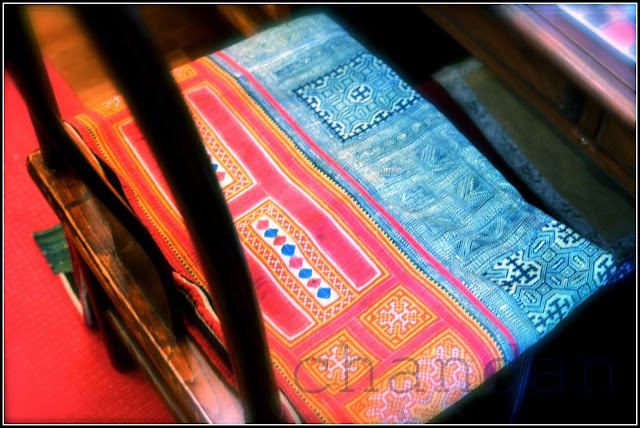Getting back to posting about Textile traditions from Asia. This one is about the most vibrant, most eclectic and most lovingly preserved traditions one will encounter. The hill tribe weaves from Indochina.

An intricate flower Hmong blanket with extensive embroidery ,
applique and batik used as alternately a throw or coverlet in the bed room.

Indigo dyed Black Hmong clothing from Vietnam. The collar, belt and sleeves are worked in
cross-stitch and applique and attached to the main garment later.
The hill tribe people from the region are diverse- almost 50 from Vietnam alone. They present a mind boggling diversity in attire, practices customs and traditions. It is impossible for the casual visitor to illustrate the whole gamut in a single blog post, it is more a subject for a serious ethnographer.
What unifies the vast number of ethnic people spread across Burma, Thailand, Vietnam, Laos and even China, to my mind is their love for textiles. Each minority is easily identifiable with their dress Most of them derive their names from the particular style of clothing they wear - Black Hmong, Flower Hmong, Red Dzao or Yao, White-trouser Yao so on.

One of the more vibrant tribes, Red yao, or Dzao clothing. Remarkable for their detachable aprons and belts worked with embroidery, applique and liberal use of woolen and metallic embellishment.

Flower Hmong blanket used as a window runner in the study room
The garments are made by the women. Harvesting and weaving the hemp, breeding silkworms, applying indigo dye, producing the batik designs, embroidering and sewing the garment and embellishing them with pompoms, shells and sequins, a virtually limitless range of techniques go into producing colorful and flamboyant dress which are utilitarian, ecologically-kind and expressive.
Have posted illustrations of the Black Hmong and the Red Yao or Dzao clothing from Vietnam. (Only I have not managed to get the right shades of indigo dyes in the illustrations which differ from the original in that respect. )

An unusual Sin ton, or belt and Plastron or Chap, of the Red Yao tribe
A lasting memory from my trip to Sapa, Vietnam is observing a Hmong household up-close. Ventured more by accident, seeking shelter from sudden rain- the half an hour spent in a ramshackle hut told me enough about the love of textiles, for the small area inhabited by the Black Hmong family was rife with fabric dying and weaving paraphernalia. A pungent smell of indigo fermenting in vats permeated the mostly cane and bamboo house. The women of the house had inky-blue hands - a tell tale sign that comes from handling indigo dyes.
The prettiest sight one will encounter roaming the emerald rice paddies of this exquisite hill station in Northern Vietnam is the sight of White Hmong and Flower Hmong women swishing voluminous skirts on the way to the weekly market. Called `skirts of thousand pleats' on account of the painstaking hand pleating that goes into creating the garment.

Flat cushion made from a Hmong jacket
A visit to the weekly Hmong market in Luang Prabang, Laos, was another occasion to arrest lasting images of a very colourful people out in their finery.
Over all the trips I have come back with stashes of textiles. Posting a few pictures from around the house and a slide show of images from Vietnam and Laos.

A child's cap embellished with wool, metal, and old coins : Red Yao tribe
Besides the colourful flamboyant clothing, the hill people use jewellery and accessories extensively, a subject that will take up an entirely different post.

20 comments:
How colorful! Love the way the eclectic colors blend in the fabrics. Great post, Chandan.
The workmanship is awesome and so is the colour combination!
Love the poster bed and how you have used the fabric on it:-)
Arch
I like the generous use of Red in the textiles :)
They derive their names form their style of clothing, that is interesting. I wonder if that sort of a thing happens with food in some parts of the world. The pictures are very pretty Chandan.
How beautiful! This was all new to me, and very informative. Thanks!
Beautiful, beautiful materials and I so wish I could visit them one day. I love ethnic groups, their cultures and especially those fabrics. Have a great weekend.
Hello chandan,
thanks for leaving a comment :)...
Am giving you the link to the picasa album of the slideshow on my blog...
http://picasaweb.google.co.in/soodtanushree/Premasim?authkey=Gv1sRgCJzPmfDnruCkOg&feat=directlink
Its really nice to see your blog and happy to meet another creative being :))
wow, this is such an incredible post!!
Tks Chandan ;-)
Lovely colours and loving red.the craftmanship is excellent.
well researched...lotus was excellent
Lovely Colors and intricate design....beautiful work.
You have a beautiful blog here, enjoyed every bit of it...
Thanx for Sharing!
Kanchan
Hi C - finally posted my tag post.
Just saw a program on the arduous task of textile making - such a beautiful labor of love. Love your photos. The black and white piece couple with the red fabric really catches my eye.
Gorgeous! I haven't seen this fabric form before, and am now going to look out for it in my travels.
PS: Did I mention that I love your photography? :)
Your blog is a delightful place to visit on the web.
Find it really interesting.
Wonderful post!
Nice post
Wonderful post!I want to share my dress boots product for your style.
What a beautiful post. Loved the story and the experience!
Every clothing business needs a textile manufacturer. Finding the right fabric supplier is just as important as designing and making the clothes themselves. Do not just choose the first one you see on the phone book. Really like to share individuals cheap towels, duvet covers fitted sheets, flat sheets, hair towels, hand towels, hotel bedding, hotel towels.
Post a Comment